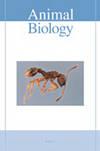Ontogenetic changes in sagitta otoliths of whitemouth croaker Micropogonias furnieri (Acanthuriformes: Sciaenidae) and its implication in acoustic communication
IF 0.9
4区 生物学
Q2 ZOOLOGY
引用次数: 0
Abstract
The otoliths of teleosts are part of the inner ear. They are related to the balance system and are also mechanical components of sound transmission, responsible for hearing in fish. Their morphology is determined by the function they perform and is also influenced by environmental factors. In this context, our goal was to: analyse the possible morphological changes of sagitta otoliths of Micropogonias furnieri (Desmarest, 1823) during its ontogeny, based on six biometric indexes. We analysed 162 sagittae otoliths of Micropogonias furnieri collected in the Rio de la Plata estuary. The variation of the indexes was associated with the different size groups. Rectangularity and aspect ratio [otolith length/total fish length (OL/TL) and sulcus area/otolith area (SA/OA)] were the indexes that contributed the most to the discriminant function. Biometric index differences were related to diverse juvenile environments. The observed shift in the SA/OA relationship could be attributable to a need to respond to a change in the perception of sound (pulse and frequency) experienced by individuals larger than 20 cm that begin to frequent the same areas as spawning adults. In this sense, the ontogenetic morphological change of sagitta otoliths plays an important role in perception and acoustic communication for this species.白口小黄鱼矢状耳石的个体发育变化及其在声通讯中的意义
硬骨鱼的耳石是内耳的一部分。它们与平衡系统有关,也是声音传播的机械部件,负责鱼的听觉。它们的形态是由它们所执行的功能决定的,也受环境因素的影响。在这种情况下,我们的目标是:分析Micropogonias furnieri (Desmarest, 1823)的矢状耳石在其个体发育过程中可能的形态变化,基于六个生物特征指标。我们分析了在la Plata河口里约热内卢采集的162具箭状耳石。各指标的变化与不同的规模组有关。矩形度和纵横比[耳石长度/鱼总长度(OL/TL)和沟面积/耳石面积(SA/OA)]是对判别函数贡献最大的指标。生物特征指数的差异与不同的幼鱼环境有关。观察到的SA/OA关系的变化可归因于需要对声音感知(脉冲和频率)的变化做出反应,这些变化是由大于20厘米的个体开始频繁出现在产卵的成年个体所经历的。从这个意义上说,矢状耳石的个体发生形态变化在该物种的感知和声音交流中起着重要作用。
本文章由计算机程序翻译,如有差异,请以英文原文为准。
求助全文
约1分钟内获得全文
求助全文
来源期刊

Animal Biology
生物-动物学
CiteScore
2.10
自引率
0.00%
发文量
34
审稿时长
3 months
期刊介绍:
Animal Biology publishes high quality papers and focuses on integration of the various disciplines within the broad field of zoology. These disciplines include behaviour, developmental biology, ecology, endocrinology, evolutionary biology, genomics, morphology, neurobiology, physiology, systematics and theoretical biology. Purely descriptive papers will not be considered for publication.
Animal Biology is the official journal of the Royal Dutch Zoological Society since its foundation in 1872. The journal was initially called Archives Néerlandaises de Zoologie, which was changed in 1952 to Netherlands Journal of Zoology, the current name was established in 2003.
 求助内容:
求助内容: 应助结果提醒方式:
应助结果提醒方式:


